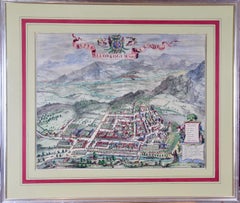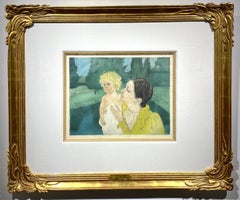Coenraet Decker Art
to
1
Overall Width
to
Overall Height
to
1
1
1
4
10,082
2,770
1,381
1,375
1
1
Artist: Coenraet Decker
Dutch Map and City Plan of La Roche-sur-Foron, France, 17th Century Hand Colored
By Coenraet Decker
Located in Alamo, CA
"Rupes Allobrogum vulgo La Roche" by Dutch engraver Coenraet Decker (1650-1685) is from the atlas Theatrum Statuum Regiae Celestudinis Sabaudiae Ducis, published in 1682. This richly...
Category
1680s Coenraet Decker Art
Materials
Engraving
Related Items
Mary Cassatt "By the Pond"
By Mary Cassatt
Located in Los Angeles, CA
Mary Cassatt 1844 - 1926
"By the Pond" (Breeskin 161; Matthews & Shapiro 21)
Drypoint and aquatint printed in colors, circa 1896, on laid paper, framed
Fourth state of four.
Plate:...
Category
1890s Coenraet Decker Art
Materials
Drypoint, Aquatint
Heinrich Ulrich after Paul Mair, Guard of Emperor Rudolph, Soldier, Landsknecht
Located in Greven, DE
Heinrich Ulrich (aka Heinrich Ullrich) (fl.1567–1621)
“Soldier with Hellebarde”, 1598, out of the series, “The Guard of Emperor Rudolph” (aka “Old German Soldiers...
Category
16th Century Renaissance Coenraet Decker Art
Materials
Engraving
Carriage engraving from the Encyclopedie ( Sellier Carossier )
By Denis Diderot
Located in New York, NY
Carriage engraving from the Encyclopedie ou Dictionnaire raisonne des sciences, des arts et des metiers, par une societe de gens de lettres. edited by Denis Diderot and Jean le Rond ...
Category
Late 18th Century French School Coenraet Decker Art
Materials
Engraving, Etching, Intaglio
$160 Sale Price
20% Off
H 16 in W 20 in
Carriage engraving from the Encyclopedie ( Sellier Carossier )
By Denis Diderot
Located in New York, NY
Carriage engraving from the Encyclopedie ou Dictionnaire raisonne des sciences, des arts et des metiers, par une societe de gens de lettres. edited by Denis Diderot and Jean le Rond ...
Category
Late 18th Century French School Coenraet Decker Art
Materials
Engraving, Etching, Intaglio
$160 Sale Price
20% Off
H 16 in W 20 in
“City Roofs” drypoint engraving by Peter Takal
By Peter Takal
Located in Berlin, MD
Peter Takal’s original drypoint engraving “City Roofs” is an accomplished work of art created in 1956. It is printed upon fine laid paper with full deckled margins as published in the limited edition of two hundred and fifty impressions. This engraving bears an embossed stamp “The Print Club of Chicago” on verso. This impression is signed by Takal in pencil. “City Roofs” is a fine example of the engraved art created by the 20th century Romanian / German / American artist, Peter Takal.
Peter Takal: Born in Romania in 1905, Peter Takal spent most of his youth in Berlin and was mainly self-taught. His first one-man exhibition took place in the Gurlitt Gallery, Berlin, in 1932. During the following seven years his art was frequently exhibited at galleries in Berlin, Munich, Paris and as well as Casablanca and Algiers. At the beginning of the Second World War (1939), Peter Takal came to the United States for an exhibition of his art at the Katherine Kuhe Gallery, Chicago. He decided to remain in the United States and became an American citizen in 1944.
Living in New York, Peter Takal quickly established himself as a leading printmaker and a modern master of both lithography and drypoint engraving. One-man exhibitions of his art took place in New York City (1942), Chicago (1939 & 1941), Washington (1959) and Los Angeles (1966). International exhibitions of his art were held at the Galeria de Arte Mexicano, Mexico City (1959), the Palazzo Strozzi, Florence, Italy (1960) and at the Kestner-Museum in Germany (1962). Museums to date that include Peter Takal's original prints in their collections are, the Chicago Art Institute, the Library of Congress, Washington, the Los Angeles County Museum of Art, the United States State Department, UCLA, the Berlin National Museum and the Bibliotheque Nationale, Paris. Over the years, the Museum of Modern Art in New York and the Arkansas Arts Center have acquired a very extensive collection of Peter Takal's lithographs and drypoints. The artist died in 1995.
The Print Club of Cleveland: Trees and Fields is an original lithograph commissioned by the Print Club of Cleveland in 1957 and published in a signed edition of 250 impressions. The Print Club of Cleveland is a non-profit adjunct organization and the country's first museum-affiliated print club devoted to the promotion of art and printmaking as a fine art for printmakers and collectors alike. With its creation in 1919, it has helped to support the growth of the department of prints and drawings at the Cleveland Museum of Fine Arts and has also been a source of great enrichment for collectors of fine prints. During the organizations long history, the club has annually commissioned one original etching engraving, lithograph, woodcut and or other form of original graphic art from such fine American artists as John Taylor Arms, Suzanne Anker, Luigi Lucioni, Will Barnet, Mark Tobey, Lyonel Feininger, Henry George Keller, Louis Lozowick, Karl Schrag, David Jansheski, Deborah Remington, and Peter Takal, as well as from leading international artists such as Henri Matisse, Edmund Blampied, Jean-Emile Laboureur, Salvador Dali, Michael di Cerbo, Phyliss Sloane, Paolo Boni, Juvenal Sanso...
Category
Mid-20th Century Abstract Coenraet Decker Art
Materials
Drypoint
Carriage engraving from the Encyclopedie ( Sellier Carossier )
By Denis Diderot
Located in New York, NY
Carriage engraving from the Encyclopedie ou Dictionnaire raisonne des sciences, des arts et des metiers, par une societe de gens de lettres. edited ...
Category
Late 18th Century French School Coenraet Decker Art
Materials
Engraving, Etching, Intaglio
$160 Sale Price
20% Off
H 16 in W 20 in
1776 Navigational chart/map of the Delaware bay and river including Philadelphia
Located in Philadelphia, PA
JOSHUA FISHER
(AMERICAN, EIGHTEENTH CENTURY)
A Chart of Delaware Bay and River, 1776
Printed for John Bennet and Robert Sayer, London
Engraving on pape...
Category
1770s Realist Coenraet Decker Art
Materials
Paper, Engraving
$5,000
H 19.5 in W 28.25 in
Architectural designs. A set of nine architectural engravings.
By Albertolli Giacondo
Located in Paris, FR
Architectural designs. A set of nine architectural engravings.
These engravings are framed in white gold covered french frames.
From the publication published in Milan in 1782.
"Diff...
Category
1780s Coenraet Decker Art
Materials
Engraving
$23,287
H 15.75 in W 11.82 in
Arrest of Christ, Engraving, a. Karel van Mander, p. by Gheyn, Passion of Chris
Located in Greven, DE
The arrest of Christ; Judas embraces Christ as a group of soldiers apprehend Him; Christ places His hand on the fearful Malchus who sits on the ground holding a lamp; Peter grips his sword; one of the soldiers holds up a flaming torch; after Karel van Mander
The scene is out of a set of 13 engravings "Passion of Christ"
Engraving
Published by: Jacques de Gheyn...
Category
17th Century Northern Renaissance Coenraet Decker Art
Materials
Engraving
$716 Sale Price
20% Off
H 13.59 in W 9.65 in
Carriage engraving from the Encyclopedie ( Sellier Carossier )
By Denis Diderot
Located in New York, NY
Carriage engraving from the Encyclopedie ou Dictionnaire raisonne des sciences, des arts et des metiers, par une societe de gens de lettres. edited ...
Category
Late 18th Century French School Coenraet Decker Art
Materials
Engraving, Etching, Intaglio
$160 Sale Price
20% Off
H 16 in W 20 in
Portrait of Baron Simolin II (large version)
By Max Beckmann
Located in Roma, RM
Max Beckmann (Leipzig 1884 – New York 1950), Portrait of Baron Simolin II (large version)(1928)
Drypoint, 38 x 25 cm (plate), 48 x 40 cm (sheet), signed and dated lower right.
Category
1920s Expressionist Coenraet Decker Art
Materials
Drypoint
Carriage engraving from the Encyclopedie ( Sellier Carossier )
By Denis Diderot
Located in New York, NY
Carriage engraving from the Encyclopedie ou Dictionnaire raisonne des sciences, des arts et des metiers, par une societe de gens de lettres. edited ...
Category
Late 18th Century French School Coenraet Decker Art
Materials
Engraving, Etching, Intaglio
$160 Sale Price
20% Off
H 16 in W 20 in
Coenraet Decker art for sale on 1stDibs.
Find a wide variety of authentic Coenraet Decker art available for sale on 1stDibs. You can also browse by medium to find art by Coenraet Decker in engraving and more. Not every interior allows for large Coenraet Decker art, so small editions measuring 33 inches across are available. Customers who are interested in this artist might also find the work of Johannes Janssonius, Cornelis Bega, and Adriaen van Ostade. Coenraet Decker art prices can differ depending upon medium, time period and other attributes. On 1stDibs, the price for these items starts at $1,675 and tops out at $1,675, while the average work can sell for $1,675.

